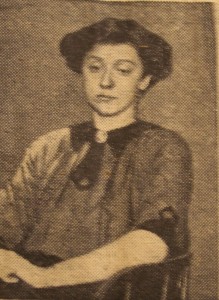A story from the archive: A Royal Visit and the Suffragette
19 August 2015In Cardiff University’s Institutional Archive there is a volume described as, ‘Royal visit, 1912 (also earlier royal visits, openings of various college buildings and degree ceremonies 1912 – 1918)’ [Ref.: UCC/CV/3]. Among other fascinating snippets, this volume contains several newspaper cuttings of the King and Queen’s visit to Cardiff in June 1912. During this visit, the King laid the foundation stone of the National Museum of Wales, as well as visiting the University College of South Wales and Monmouthshire (as Cardiff University was then known), and Llandaff Cathedral. It was during the journey to Llandaff that the Suffragette incident occurred.
What is interesting is how the different newspapers bound in this volume report on the incident. A fair few newspapers ignore the incident altogether, concentrating on the pomp, ceremony and sunshine of the day of the royal visit. To say that the Daily Mail reports on the incident may well be an overstatement but it is, at least, mentioned and quickly dismissed:
In the afternoon their Majesties motored to Llandaff Cathedral, and on their arrival a Suffragette rushed forward and seized Mr McKenna, the Minister in attendance, by the arm. She was removed by a detective.
Daily Mail, June 1912
The Daily Telegraph is similarly dismissive, taking a more hostile approach to the incident:
While the Royal party was proceeding to the building, a woman jumped a wall and rushed towards the Home Secretary, who was in attendance, threatening vengeance for “the suffrance of the women in Holloway.” The women’s action really fell very flat, though doubtless she received the advertisement she desired. The only person excited by the incident was the woman herself. Everyone recognised that the object of her attack was not the King and Queen, but for Mr McKenna, and it is rather fortunate for the Suffragist that the spectators understood her purpose, for she would have run the risk of a severe handling from the crowd if she had forced her attentions on their Majesties. As it was, the woman, who is not a resident of the district, was loudly hooted. The police liberated her after an hour’s detention.
Daily Telegraph, June 1912
The Telegraph’s report underplays the impact of the incident, implying a disappointing lack of public support, informing readers that it ‘fell flat’ and that she was ‘loudly hooted’.
Both of these papers deprive the woman of an identity and largely hide her motives. Meanwhile, the Daily Sketch appears to have given the cause a platform. Its report on the incident named the woman, detailed her motivations and was accompanied by a large picture. Under the headline, “…Remarkable Suffragist Outrage”, it reports:
A remarkable incident occurred as the Royal party was approaching Cathays Park. A lady, who subsequently gave her name as Helen Craggs, sprang at the Home Secretary, who was in attendance on their Majesties. She shouted at Mr McKenna that it was a shame he was going about the country where suffragists were starving in prison, and had to be removed by force.
Daily Sketch, June 1912

This picture of Helen Craggs is from the Daily Sketch. She was the daughter of Sir John Craggs MVO and entered into full-time employment as an organiser for the Women’s Social and Political Union. Having been imprisoned in Holloway in March 1912, she had first-hand experience of the suffering which motivated her protest.
(For a fuller biography of Helen Craggs, see Elizabeth Crawford, The Women’s Suffrage Movement: A Reference Guide 1866-1928 (Routledge, 2003), pp. 146-147.)
- Hack your records! 10 simple steps for better records management
- Inspirational People: 3. Kathleen Freeman – Classicist and Fiction Writer
- Dr Mina Moore: marriage and motherhood at Cardiff University in the 1940s
- Inspirational People: 2. Mary “Eppynt” Phillips – The First Female Graduate of the Medical School at Cardiff
- Serendipitous discoveries: a vignette of Percy Bush, early C20th Welsh rugby player